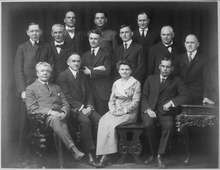Council of National Defense
The Council of National Defense was a United States organization formed during World War I to coordinate resources and industry in support of the war effort, including the coordination of transportation, industrial and farm production, financial support for the war, and public morale.

 | |
| Agency overview | |
|---|---|
| Formed | August 24, 1916 |
| Preceding agencies |
|
| Dissolved | 1921 (suspended) Briefly revived for WWII to hold agencies such as National Defense Research Committee (WWII) |
| Superseding agencies | |
| Jurisdiction | United States Government |
| Headquarters | Washington, D.C. |
| Agency executives |
|
| Parent agency | Executive Office of the President |
| Child agencies |
|
It was briefly revived for World War II[2] to hold agencies such as National Defense Research Committee.
Organizational history
Establishment
The Army appropriation for 1916 provided for the creation and funding of the Council of National Defense.[3] The appropriation was $200,000.[4] President Woodrow Wilson established it on August 24, 1916,[5] because "The Country is best prepared for war when thoroughly prepared for peace."[4]
Members of some portions, such as the Medical Officers' Reserve Corps, which had existed previously as the Medical Reserve Corps, reverted to their former roles preparing for emergencies.[6]
Structure
The council consisted of the Secretary of War, the Secretary of the Navy, the Secretary of the Interior, the Secretary of Agriculture, the Secretary of Commerce, and the Secretary of Labor.[7] The council was to investigate and advise the president and heads of executive departments, on the strategic placement of industrial goods and services for the potential and future use in times of war.[5]
The President appointed a nonpartisan advisory commission associated with the council in October 1916.[4] The commission comprised seven men with specialized knowledge in a profession or field of industry.[7] Its first members were Daniel Willard (Baltimore, Maryland), president of the Baltimore and Ohio Railroad; Samuel Gompers (Washington, D.C.), president of the American Federation of Labor; Dr. Franklin H. Martin (Chicago, Illinois), a distinguished surgeon who founded the American College of Surgeons; Howard E. Coffin (Detroit, Michigan), head of the Committee on Industrial Preparedness, who had experience coordinating the auto industry in emergencies; Bernard Baruch (New York, New York), a prominent banker; Dr. Hollis Godfrey, civil engineer [8] (Philadelphia, Pennsylvania), president of the Drexel Institute; and Julius Rosenwald (Chicago, Illinois), president of Sears, Roebuck & Co.[4] Walter S. Gifford, of the American Telegraph and Telephone Company, also an engineer, served the first Director of the Council,[9] but was succeeded by Grosvenor Clarkson.[10]
Beginning in May 1917, the Council asked individual states to create their own Councils of Defense to assist the federal Council in carrying out its work.[3] Some formed separate Women's Committees of National Defense and Southern states, at the urging of the National Council, formed organizations for Negroes.[3]
In January 1920, the Council recommended the creation of an Expert Survey Board to conduct research studies over the next six months to enable speedy mobilization in the event of another war.[11]
Disestablishment
The activities of the Council of National Defense were suspended in 1921.[3]
See also
- Committee on Public Information —Disbanded 1919 and records transferred to CND.
- National Defense Research Committee
- United States Housing Corporation
Footnotes
- Herman, Arthur. Freedom's Forge: How American Business Produced Victory in World War II, pp. 127, 137-9, Random House, New York, NY, 2012. ISBN 978-1-4000-6964-4.
- "Records of the Council of National Defense". National Archives. August 15, 2016. Retrieved December 10, 2016.
- Green, Walter G., ed., Electronic Encyclopaedia of Civil Defense and Emergency Management, "Council of National Defense and State Defense Councils," August 17, 2003 Archived July 22, 2011, at the Wayback Machine, accessed May 9, 2011
- "President Names Defense Advisors". The New York Times. 1916-10-12. Retrieved 2008-02-23.
- "Title 50: Chapter 1: Council of National Defense". U.S. House of Representatives Downloadable U.S. Code. January 2, 2006. Archived from the original on February 28, 2008. Retrieved 2008-02-24.
- Emerson, William K., Encyclopedia of United States Army insignia and uniforms, 183, available online
- "Laws: Cases and Codes : U.S. Code : Title 50. War And National Defense". FindLaw. Retrieved 2008-02-24.
- Nunn, Jack H. (October 1979). "MIT: A University's Contributions to National Defense". Military Affairs. Society for Military History. 43 (3): 120–125. doi:10.2307/1986870. JSTOR 1986870.
- Engineering news-record. v.78 1917., Cited in Pursell, Carroll. "Engineering Organization and the Scientist in World War I: The Search for National Service and Recognition." Prometheus 24.3 (2006): 257-268.
- HEADS DEFENSE COUNCIL.; Grosvenor B. Clarkson Succeeds W. S. Gifford as Director., The New York Times
- "War Preparedness Methods Proposed". The New York Times. 1920-01-26. Retrieved 2011-05-09.
Further reading
- William J. Breen, Uncle Sam at Home: Civilian Mobilization, Wartime Federalism, and the Council of National Defense, 1917-1919. Westport, CT: Greenwood Press, 1984.